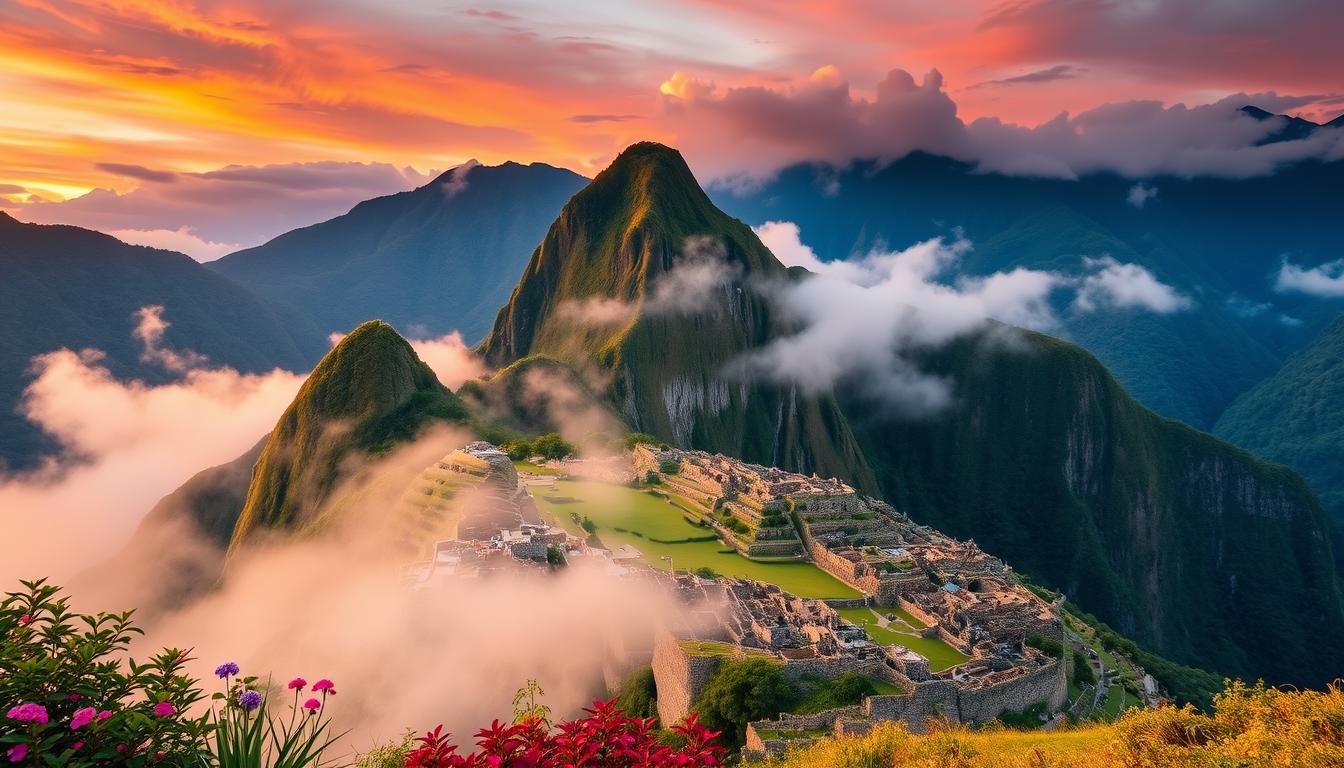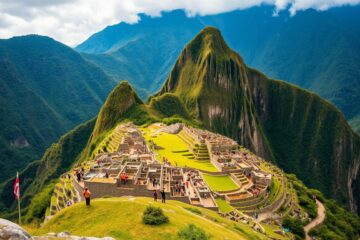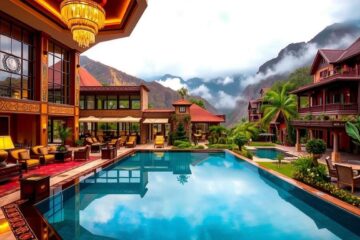Machu Picchu is an Inca citadel in Peru’s Andes mountains. It shows the grandeur of the ancient Inca civilization. Its stunning beauty and architecture make it a top spot for history, culture, and nature lovers.
Machu Picchu sits at about 7,970 feet above sea level. It’s on a mountain ridge above the Urubamba Valley. The main way to get there is from Cusco, which is around 11,100 feet up. Guides from Natural Habitat Adventures are recommended. They have 15 years of experience and offer trips all year, lasting 7 days.
We’ll look into Machu Picchu’s history. This includes its construction, importance as an Inca citadel, and its discovery by the West. We’ll gain a deeper understanding of Machu Picchu’s history.
Key Takeaways
- Machu Picchu is an Inca citadel in Peru’s Andes mountains, offering deep historical insights.
- The site is at about 7,970 feet above sea level. It has stunning beauty and impressive architecture, making it a unique part of Machu Picchu history.
- Natural Habitat Adventures offers 7-day trips to Machu Picchu. They have experienced guides and focus on sustainability, providing an immersive experience.
- The average cost of a Machu Picchu expedition is $6,995, excluding airfare. Group sizes are limited to 12 guests for a more intimate exploration.
- The carbon emissions from trips are 100% offset, including round-trip flights. Natural Habitat Adventures became carbon-neutral in 2007, aligning with its mission to preserve cultural heritage.
- Travelers can reach Machu Picchu by train or bus from Cusco, or by hiking the Inca Trail. The Inca Trail requires a permit booked well in advance, offering a unique perspective.
- Many travelers recommend booking flights and train tickets well in advance, during the high season. This ensures a smooth and enjoyable experience.
The Discovery of Machu Picchu: A Historical Overview
Machu Picchu’s story is one of discovery, adding to its mystique. It all started with American historian Hiram Bingham in 1911. He was searching for the lost city of Vilcabamba when he found Machu Picchu.
Bingham’s find marked a new chapter in archaeology. It opened up Machu Picchu to the world, sparking a wave of research and exploration. Let’s dive into Bingham’s journey and how it changed our view of this ancient Inca city.
Hiram Bingham and His Expedition
Hiram Bingham’s expedition to Machu Picchu was a game-changer. He and his team uncovered the ruins, showing off the city’s advanced urban design. This discovery drew many to Machu Picchu, eager to learn more about it.
The Significance of the 1911 Discovery
The 1911 find of Machu Picchu was a turning point. It started a new era of study and exploration. Today, Machu Picchu is a global icon, drawing millions each year. Its rich history and cultural importance make it a must-see for anyone interested in archaeology.
| Year | Event | Significance |
|---|---|---|
| 1911 | Discovery of Machu Picchu | Marked the beginning of a new era of Machu Picchu exploration and research |
| 1913 | Publication of Bingham’s discovery | Sparkled a wave of interest in Machu Picchu archaeological research |
| 1983 | Designation as a UNESCO World Heritage Site | Recognized the site’s cultural and historical significance |
The Inca Civilization: Contextual Background
The Inca civilization was a vast and powerful empire. It stretched across the Andes Mountains. It left behind a legacy, including the magnificent Machu Picchu ancient civilization. To understand Machu Picchu’s significance, we must explore the Inca civilization’s origins and achievements.
Historical records show the Inca Empire was advanced. They made big strides in architecture, engineering, and agriculture. Their work, like Machu Picchu, shows their architectural prowess and engineering skills.
For those interested in the Inca civilization and Machu Picchu, many resources are available. Peru adventure tours and excursions offer a deep dive into their history and culture. These tours also let you explore Peru’s stunning landscapes.
The Origins of the Incas
The origins of the Incas are still a mystery. But, it’s believed they started in the 13th century in Peru’s Cusco region. They then expanded, conquering and merging with other tribes and civilizations.
Major Achievements of the Inca Empire
The Inca Empire achieved a lot in architecture, engineering, and agriculture. They built wonders like Machu Picchu. They also developed advanced irrigation systems and a vast network of roads and trails.
Architectural Wonders of Machu Picchu
Machu Picchu is famous for its amazing architecture. It shows the engineering and building skills of the Incas. The site sits on a mountain ridge, built to last against the Andes’ harsh weather.
The Incas built it using stone blocks that fit together without mortar. This highlights the Machu Picchu historical significance of this ancient city.
The Machu Picchu architectural wonders include the Temple of the Sun and the Temple of Three Windows. There’s also the Intihuatana stone, which aligns with celestial events. These show the Incas’ advanced knowledge of astronomy.
These structures prove the Incas could adapt to tough terrain. They also show their deep understanding of the local environment.
- Precise stone-fitting without mortar, which increased the structures’ stability and durability against earthquakes.
- Terraces and water distribution systems, which demonstrate advanced agricultural practices and significant understanding of local environmental conditions.
- Alignment of structures with celestial events, which indicates the Incas’ advanced astronomical knowledge and involvement in culturally significant practices tied to their religious beliefs.
These architectural wonders prove the Machu Picchu historical significance. They show the Incas’ advanced engineering and construction skills. This makes Machu Picchu one of the most impressive and mysterious sites in the world.
Cultural Significance of Machu Picchu
Machu Picchu holds deep cultural value, showing the rich Machu Picchu cultural heritage and Inca cultural practices. It was a key spiritual and religious spot. It boasts over 200 archaeological structures, like temples, terraces, and homes.
The Incas lived by farming, trading, and making crafts. They had a complex society, with the emperor leading and many nobles, priests, and artisans below. The site’s design and engineering show the Incas’ advanced skills and technology.
- Spiritual and religious practices, such as ceremonial rituals and sacrifices
- Daily life and social structure, including agriculture, trade, and craftsmanship
- Advanced engineering and architectural skills, reflected in the site’s construction and design
| Aspect of Machu Picchu | Description |
|---|---|
| Spiritual Significance | Important spiritual and religious center for the Incas |
| Daily Life | Centered around agriculture, trade, and craftsmanship |
| Architectural Engineering | Advanced skills reflected in the site’s construction and design |
Theories about Machu Picchu’s Function
Machu Picchu’s purpose has sparked debate among historians and archaeologists. Built in the 15th century, it was during the Inca emperor Pachacuti’s reign. Some think it was an agricultural center, while others believe it was a royal retreat or ceremonial site.
The architecture and layout give hints about its functions. The terraces suggest farming. Yet, the stonework and ceremonial structures, like the Temple of the Sun, hint at a spiritual or ceremonial role.
- Agricultural center: The site’s terraces and irrigation system suggest that it may have been used for farming.
- Royal retreat: The site’s luxurious architecture and stunning views suggest that it may have been a retreat for the Inca elite.
- Ceremonial center: The presence of ceremonial structures, such as the Temple of the Sun, suggests that the site may have been used for spiritual or ceremonial purposes.
| Theory | Description |
|---|---|
| Agricultural center | The site’s terraces and irrigation system suggest that it may have been used for farming. |
| Royal retreat | The site’s luxurious architecture and stunning views suggest that it may have been a retreat for the Inca elite. |
| Ceremonial center | The presence of ceremonial structures, such as the Temple of the Sun, suggests that the site may have been used for spiritual or ceremonial purposes. |
The Machu Picchu historical context and Machu Picchu function are complex and multifaceted. They continue to be the subject of ongoing research and debate.
Preservation Efforts Through The Years
Machu Picchu’s preservation has been a big deal for decades. Efforts have focused on stopping erosion, climate change, and tourism’s effects. In 1983, it was named a UNESCO World Heritage Site. This move highlighted its cultural and natural value, sparking more protection efforts.
Challenges in preserving Machu Picchu include:
- Too many tourists, causing erosion and damage
- Climate change, altering temperatures and rain, affecting the site’s stability
- Not enough money and resources for conservation
Despite these hurdles, many groups and individuals are working hard. They aim to protect Machu Picchu for future generations. Machu Picchu conservation efforts include controlling visitor numbers, promoting eco-tourism, and supporting local communities.
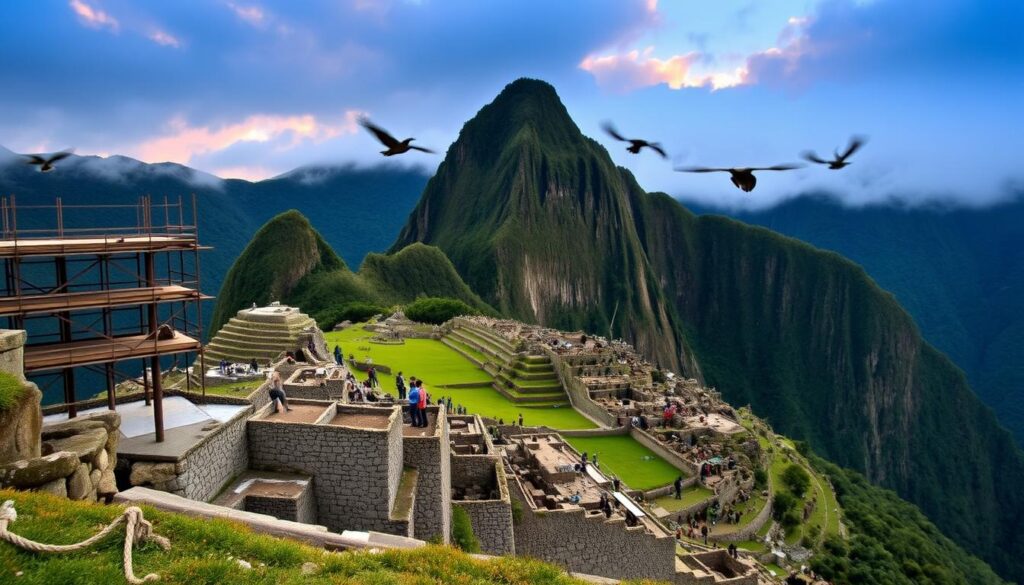
Supporting Machu Picchu’s preservation helps protect this amazing site and its cultural heritage for the long term.
| Year | Event | Impact on Machu Picchu Preservation |
|---|---|---|
| 1983 | Designated a UNESCO World Heritage Site | Raised awareness about the importance of Machu Picchu conservation |
| 2000s | Implementation of sustainable tourism practices | Reduced the impact of tourism on the site |
| 2010s | Increased funding for conservation efforts | Supported the protection and preservation of the site |
Machu Picchu Today: Tourism and Its Impact
Machu Picchu is a top spot for tourists in South America, drawing about 900,000 visitors each year. This big number of people boosts the local economy. It creates jobs and chances for businesses in hotels, transport, and tours.
The Machu Picchu tourism world is key to the local economy. But, it also raises environmental worries. Too many visitors can harm the site, causing erosion, pollution, and damage to habitats. This threatens the Machu Picchu environmental impact.
To lessen these problems, the Peruvian government and global groups are teaming up. They aim to make tourism more sustainable and manage how many people visit.
Some important facts about tourism’s effect on Machu Picchu are:
- About 2,500 tourists go to Machu Picchu every day.
- There are plans to limit daily visitors to 800 to 4,000.
- Machu Picchu is seen as one of the fastest-deteriorating World Heritage Sites.
There are efforts to keep the economic benefits of tourism while protecting the site’s culture and nature. By supporting green tourism and conservation, visitors can reduce their Machu Picchu environmental impact. This helps keep this amazing place safe for the future.
The Legacy of Machu Picchu in Popular Culture
Machu Picchu is more than just a historical site. It has become a symbol in popular culture. Its mysterious atmosphere has inspired many works of literature, art, and film. As a UNESCO World Heritage site, it’s known for its stunning views and the mystery of its past.
Many artists and writers find inspiration in Machu Picchu’s stonework and the Andean landscape. In movies and media, it stands for adventure and the secrets of the Inca civilization.
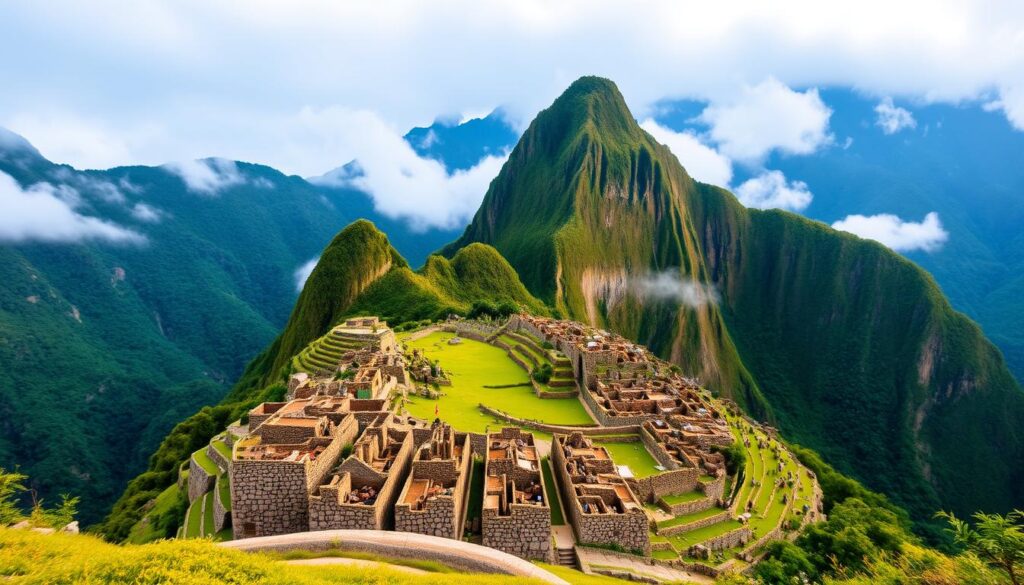
Representation in Literature and Art
Machu Picchu has inspired countless works. Novels, paintings, and more have been influenced by its beauty and architecture. It has captured the hearts of creatives from all over the world.
Machu Picchu in Film and Media
In films and media, Machu Picchu is a setting for stories of adventure and discovery. Its Machu Picchu representation highlights its beauty and its Machu Picchu cultural significance. It stands as a symbol of the Inca civilization’s achievements and mysteries.
Future of Machu Picchu: What Lies Ahead?
Looking ahead, Machu Picchu’s future is tied to tourism and conservation efforts. With over 1.5 million visitors each year, it boosts local and national economies. Yet, this growth raises concerns about the environment and the need for sustainable tourism.
Efforts are being made to protect this cultural gem for the long term.
Sustainable Tourism Initiatives
are being put in place to lessen tourism’s environmental impact. This includes eco-friendly tours and responsible travel. Research and new discoveries also add to the site’s history, enriching the visitor experience.
The Peruvian government has set a daily visitor limit of 2,500 to protect the site. There’s also a growing need for more educational resources on Incan history. As the
Machu Picchu Future
evolves, finding a balance between tourism and conservation is key. This ensures the site remains a wonder for future generations. By supporting
Machu Picchu Sustainable Tourism
efforts, we can safeguard the site’s biodiversity and cultural heritage. This also promotes responsible and respectful travel.
